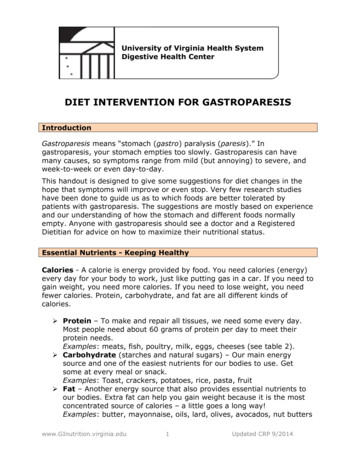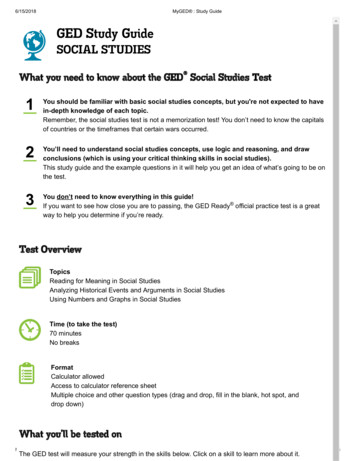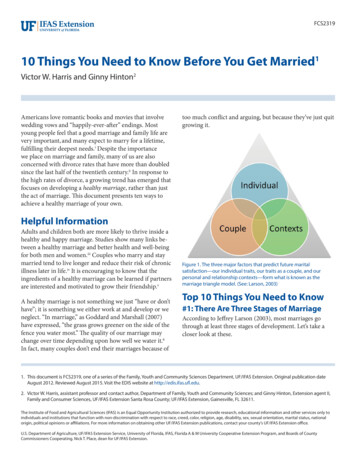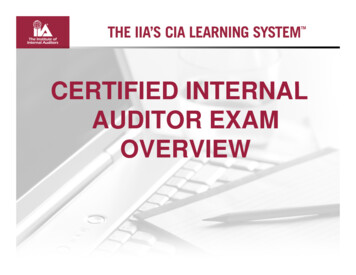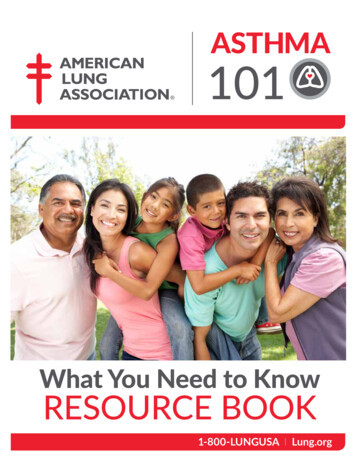
Transcription
What You Need to KnowRESOURCE BOOK1-800-LUNGUSA l Lung.org
Asthma 101 What You Need to Know was createdby a collaborative effort of the mission team of theAmerican Lung Association of the Upper Midwest.
Table of ContentsSCOPE OF ASTHMA . . . . . . . . . . . . . . . . . . . . . . . . . . . . . . . . . . . . . . . . . . . . . . . . . . . . . . . . . . . . . . . . . . . . . . . . . . . . . . . 4The Lungs in Asthma. . . . . . . . . . . . . . . . . . . . . . . . . . . . . . . . . . . . . . . . . . . . . . . . . . . . . . . . . . . . . . . . . . . . . . . . . . . . . 5Diagnosis of Asthma. . . . . . . . . . . . . . . . . . . . . . . . . . . . . . . . . . . . . . . . . . . . . . . . . . . . . . . . . . . . . . . . . . . . . . . . . . . . . 6Classification of Asthma. . . . . . . . . . . . . . . . . . . . . . . . . . . . . . . . . . . . . . . . . . . . . . . . . . . . . . . . . . . . . . . . . . . . . . . . . . 6Common Asthma Triggers . . . . . . . . . . . . . . . . . . . . . . . . . . . . . . . . . . . . . . . . . . . . . . . . . . . . . . . . . . . . . . . . . . . . . . . . 7MEDICATIONS . . . . . . . . . . . . . . . . . . . . . . . . . . . . . . . . . . . . . . . . . . . . . . . . . . . . . . . . . . . . . . . . . . . . . . . . . . . . . . . . . . . 11Getting Help From the Professionals. . . . . . . . . . . . . . . . . . . . . . . . . . . . . . . . . . . . . . . . . . . . . . . . . . . . . . . . . . . . . . 12Goals of Medication Therapy. . . . . . . . . . . . . . . . . . . . . . . . . . . . . . . . . . . . . . . . . . . . . . . . . . . . . . . . . . . . . . . . . . . . . 12Asthma Medications Chart . . . . . . . . . . . . . . . . . . . . . . . . . . . . . . . . . . . . . . . . . . . . . . . . . . . . . . . . . . . . . . . . . . . . . . 13Medication Delivery Devices. . . . . . . . . . . . . . . . . . . . . . . . . . . . . . . . . . . . . . . . . . . . . . . . . . . . . . . . . . . . . . . . . . . . . 15ASTHMA ACTION PLAN. . . . . . . . . . . . . . . . . . . . . . . . . . . . . . . . . . . . . . . . . . . . . . . . . . . . . . . . . . . . . . . . . . . . . . . . . . . 23Importance of an Asthma Action Plan. . . . . . . . . . . . . . . . . . . . . . . . . . . . . . . . . . . . . . . . . . . . . . . . . . . . . . . . . . . . . 24Basic Asthma Management. . . . . . . . . . . . . . . . . . . . . . . . . . . . . . . . . . . . . . . . . . . . . . . . . . . . . . . . . . . . . . . . . . . . . . 24Emergency Asthma Management. . . . . . . . . . . . . . . . . . . . . . . . . . . . . . . . . . . . . . . . . . . . . . . . . . . . . . . . . . . . . . . . . 26Emergency Action Plan. . . . . . . . . . . . . . . . . . . . . . . . . . . . . . . . . . . . . . . . . . . . . . . . . . . . . . . . . . . . . . . . . . . . . . . . . . 26Asthma Action Plan. . . . . . . . . . . . . . . . . . . . . . . . . . . . . . . . . . . . . . . . . . . . . . . . . . . . . . . . . . . . . . . . . . . . . . . . . . . . . 27CONTROL OF ASTHMA . . . . . . . . . . . . . . . . . . . . . . . . . . . . . . . . . . . . . . . . . . . . . . . . . . . . . . . . . . . . . . . . . . . . . . . . . . . 29Goals of Asthma Management . . . . . . . . . . . . . . . . . . . . . . . . . . . . . . . . . . . . . . . . . . . . . . . . . . . . . . . . . . . . . . . . . . . 30Is Your Asthma Out of Control?. . . . . . . . . . . . . . . . . . . . . . . . . . . . . . . . . . . . . . . . . . . . . . . . . . . . . . . . . . . . . . . . . . . 31Asthma Control Test. . . . . . . . . . . . . . . . . . . . . . . . . . . . . . . . . . . . . . . . . . . . . . . . . . . . . . . . . . . . . . . . . . . . . . . . . . . . 32EXERCISE AND ASTHMA . . . . . . . . . . . . . . . . . . . . . . . . . . . . . . . . . . . . . . . . . . . . . . . . . . . . . . . . . . . . . . . . . . . . . . . . . . 33Exercise-induced Bronchospasm . . . . . . . . . . . . . . . . . . . . . . . . . . . . . . . . . . . . . . . . . . . . . . . . . . . . . . . . . . . . . . . . . 34Indoor Air Quality Checklist. . . . . . . . . . . . . . . . . . . . . . . . . . . . . . . . . . . . . . . . . . . . . . . . . . . . . . . . . . . . . . . . . . . . . . 35ADDITIONAL INFORMATION. . . . . . . . . . . . . . . . . . . . . . . . . . . . . . . . . . . . . . . . . . . . . . . . . . . . . . . . . . . . . . . . . . . . . . 39Asthma/Allergy Connection. . . . . . . . . . . . . . . . . . . . . . . . . . . . . . . . . . . . . . . . . . . . . . . . . . . . . . . . . . . . . . . . . . . . . . 40Food Allergies. . . . . . . . . . . . . . . . . . . . . . . . . . . . . . . . . . . . . . . . . . . . . . . . . . . . . . . . . . . . . . . . . . . . . . . . . . . . . . . . . . 42Frequently Asked Questions. . . . . . . . . . . . . . . . . . . . . . . . . . . . . . . . . . . . . . . . . . . . . . . . . . . . . . . . . . . . . . . . . . . . . 43Certificate of Attendance. . . . . . . . . . . . . . . . . . . . . . . . . . . . . . . . . . . . . . . . . . . . . . . . . . . . . . . . . . . . . . . . . . . . . . . . 45References . . . . . . . . . . . . . . . . . . . . . . . . . . . . . . . . . . . . . . . . . . . . . . . . . . . . . . . . . . . . . . . . . . . . . . . . . . . . . . . . . . . . 473
Scope of AsthmaChildhood Asthma Asthma is the most common chronic disorder in childhood, currently affecting an estimated 6.1 million children under 18years; of which 3.5 million suffered from an asthma episode in 2013.1 Secondhand smoke can cause serious harm to children. An estimated 400,000 to one million asthmatic children havetheir condition worsened by exposure to secondhand smoke.2 Asthma can be a life-threatening disease if not properly managed. In 2013, 3,630 deaths were attributed to asthma.However, deaths due to asthma are rare among children. The number of deaths increases with age. In 2013, 218 childrenunder 18 died from asthma.1 Asthma is the third leading cause of hospitalization among children under the age of 15. Approximately 32.7% of allasthma hospital discharges in 2006 were in those under 15; however, only 20.1% of the U.S. population was less than15 years old.4 In 2010, there were approximately 439,000 emergency room visits due to asthma in those under 18.2 Asthma is one of the leading causes of school absenteeism.6 In 2008, asthma accounted for an estimated 14.4 millionlost school days in children with an asthma episode in the previous year. 6,7Adult Asthma The number and rate of hospital discharges for asthma peaked in 1995. Since that time, the number of discharges hasdecreased and the discharge rate has declined. During 2010, 439,000 discharges (14.1 per 10,000) were due to asthma.2 More than 300,000 adult emergency room visits were attributed to asthma in 2010.2 In 2008, asthma accounted for an estimated 14.2 million lost work days in adults.12 The annual direct health care cost of asthma is approximately 50.1 billion; indirect costs (e.g. lost productivity) addanother 5.9 billion, for a total of 56.0 billion dollars.134
The Lungs in AsthmaNormal Lung TissueAsthma is a chronic inflammatory disorder of the airways thatcauses three primary changes in the lungs: Inflammation (swelling) of the lining of the airways Bronchoconstriction (tightening of the bands of smooth musclessurrounding the airways) which reduces the width of the airways Excess mucus production that further narrows the airwaysAsthmaAsthma is an obstructive disease that may cause permanent changes(remodeling) if not properly treated. Asthma is a disease that cannot be curedbut can be controlled.Demonstration ActivitiesTo get an idea of what an asthma episode feels like, try one of the followingexercises.Cautionary Note: If participants have asthma or other breathing problems, this may exacerbatetheir breathing difficulties. They should not participate in these activities.Straw ActivityAsthma DemonstrationYou’ll need a watch or clock with a second handand a drinking straw. Make an “O” with your fingers andthumb.Like this: Exercise in place for 30-60 seconds. Put your fist to your mouth andbreathe in and out for a fewseconds. This is what it’s normallylike to breathe. Place a straw in your mouth. Seal your lipsaround the straw. Pinch your nostrils shut. Breathe in and out through the straw for 15seconds. Pinch the straw in the middle to restrict andnarrow the size of the opening. Take additional breaths. Remove straw and breathe normally.Imagine what it must be like to feel like this forprolonged periods during an actual asthma episode.Think how hard it must be to concentrate whenyou can’t breathe. Imagine how difficult it would beto climb a flight of stairs, walk down a long hallwayto reach the school nurse or school office or get tothe locker room to obtain prescribed medicationswhen each breath is an effort. Tighten your fist (make the “O”smaller) and place your fist to yourmouth.Like this: Breathe in and out again for just acouple of seconds. This is what it can feel like when someone hasasthma.When someone has asthma three things happen that make itharder for them to get air in and out of their lungs: Airways swell (inflammation) Muscles around their airways tighten (bronchoconstriction) Too much mucus is producedThe above exercise demonstrates the muscle tightening and airwayswelling.5
Diagnosis of AsthmaA diagnosis of asthma can be made by a health care professional through assessment of symptoms,medical history, physical examination and spirometry—a simple breathing test.Diagnosing asthma in infants is often difficult, yet under-diagnosis and under-treatment are keyproblems in this age group. A detailed history of symptoms and a physical exam is a vital and importantpart of diagnosing asthma at any age.SymptomsAlthough symptoms may vary for each person with asthma, the primary symptoms of an asthmaepisode may include: Wheeze Cough Shortness of breath Chest tightness RetractionsRemember, all symptoms should be taken seriously. Please note that cough may be the only symptom. Some people with asthma maynever wheeze.Classification of AsthmaPart of managing asthma includes assessing the severity of a person’s asthma. This includes assessingnight and daytime symptoms, plus a breathing test (spirometry). A person with asthma may be assessedat one of several different levels. The four levels of severity are intermittent, mild persistent, moderatepersistent and severe persistent.6
Common Asthma TriggersThere are many common substances that can start an asthma episode. These substances, along withenvironmental conditions, are commonly referred to as triggers. Triggers cause asthma symptoms to begin or getworse. Asthma triggers may differ between individuals, what affects one person may not affect another.If known triggers are present, susceptible people should be protected from exposure to the triggering agents andwhenever possible, be removed from exposure to the trigger. Travel, outdoor activities (camping), and holidaysoften present unique challenges for asthma management. The following chart includes common agents andconditions that might trigger an asthma episode, possible sources, and strategies that can be used to reduce orcontrol triggers.Triggers and Control StrategiesINFECTIONSColds, upper respiratory tract infections, influenza, sinusitis, andrespiratory synsitial virus (RSV) may aggravate asthma symptoms. Diagnosing and treating upper respiratory tract infections and disease (rhinitis/sinusitis) is an integral part of managing asthma. Wash hands often. Use paper towels. Don’t share cups, toothbrushes, towels or tissues. Keep hands away from face. Get an influenza shot yearly.ALLERGENSPets with fur and feathersAnimalsBest option is to find a new home for family pets. If removal is not acceptable, Keep the pet out of the child’s bedroom and keep doors closed. Keep pets off of furniture. Wash the pet weekly to reduce the amount of dander. Vacuum with high efficiency particulate accumulator (HEPA) filter and dust weekly. Use a filter on air ducts in the child’s room. Take allergy medications, as prescribed. Damp dust weeklyCockroachesInfested buildings, kitchens, garbage, leaky faucets and pipes Do not leave food or garbage exposed. Store garbage in outside trash container. Poison baits or traps are preferred to chemical agents. Fixing leaky faucets will minimize cockroaches.7
Dust MitesMicroscopic organisms found in carpeting, pillows, upholstery, stuffed animals, bedding,draperies Encase pillows, mattress, and box spring in an allergen impermeable cover. Wash bedding in hot water weekly. Do not sleep on upholstered furniture. Reduce indoor humidity to less than 50%. Minimize stuffed toys in child’s bedroom. Vacuum (HEPA filter) and dust weekly.Mold andYeast SporesShowers, restrooms, basements, materials and containers stored in damp areas,leaky roofs, old books and newspapers, exercise and athletic mats, vaporizers/roomhumidifiers, aquariums, plants Fix leaky faucets and pipes. Clean visible mold with a stiff brush, hot water and non-ammonia soap. Run a dehumidifier and empty collection bucket daily. Use the exhaust fan in bathroom when bathing and above the stove when cooking. Throw away moldy items. Reduce indoor humidity to less than 50%.PollensFlowering trees and plants, cut flowers, grasses, weeds, gardens, nature walks, seasonaldecorations Be aware of daily pollen counts in your area. Limit time outside during high pollen seasons. Keep windows closed and run air conditioner. Shower and wash hair before going to bed. Take allergy medications. Use an air cleaner that does not emit ozone in bedroom.8
Foods/AdditivesPeanuts, soy eggs, dairy products, fish, wheat, sulfites (found in dried fruits, shrimp, wine)food preservatives, additives such as MSG and food dyes. For some people’s allergies and sensitizations, exposure to ANY amount of allergicfood or chemical could lead to mild to life-threatening reactions. Be aware of ingredients in processed and homemade foods.Medical ConditionsAcid reflux, sensitivity to aspirin, non-steroidal anti-inflammatory medications andmedications (NSAIDs) and beta-blockers Appropriate treatment of reflux can minimize asthma episodes. Talk with health care provider about alternative medications.IRRITANTSSmokeExposure to any type of smoke—cigarette, cigar and secondhand smoke, wood, coal,leaf burning, industrial waste, chemistry labs, kitchen Permit NO smoking in the home or around the person with asthma. If caregivers mustsmoke, wear a smoking jacket and smoke outside. If caregivers must smoke, wear a smoking jacket, smoke outside and leave the jacketoutside. Do not bring it back into the home. It could trigger an asthma episode (attack). Help parents and caregivers quit smoking. Avoid exposure to outdoor burning, camp fires and other smoky areas.Dust/Chalk DustChalkboards, dust Vacuum (HEPA filter) and dust weekly. Do not clap chalkboard erasers.WeatherExposure to cold air or high humidity Monitor local weather forecast and high ozone alert days. Keep windows closed and use air conditioning when pollen, smog or humidity levelsare high. Cover face with a scarf or wear a medical mask during weather changes or on dayswith poor air quality.9
Aerosols, StrongOdors and FumesCleaning solutions, perfumes and colognes, paints, fumigation chemicals, roomdeodorizers, art supplies, roofing tars, sealants, traffic fumes, biology or chemistry labs Avoid or limit use of perfumes, scented deodorants, lotions, hairsprays, cleaningproducts, chemicals, candles and incense. Minimize breathing in automobile and bus fumes when waiting for publictransportation. Wear a scarf or stand at the front of the stop, not at the end nearfumes. Room should have proper ventilation. Clean room when person with asthma is away and ventilate before they return. Minimize contact.BEHAVIORSEmotionsCrying, laughing, stressful situations Emotions are REAL triggers and can cause an asthma episode.Exercise-inducedAlso referred to as exercise-induced bronchospasm, it is not a separate disease.Exercise can trigger an asthma episode. It is often caused by cold, dry air that canproduce a spasm in the airways. Warm up before and cool down after exercising. Follow health care provider’s advice on pre-medication. Quick relief medications should always be available close by during physicalexertion. Monitor air quality and only exercise outside when air quality is good.10
MEDICATIONS
Getting Help From the Professionals It is important for someone with asthma to see his/her healthcare provider regularly. A healthcareprovider can help someone with asthma identify triggers and work to find the right medicines to controlsymptoms. To keep asthma controlled, someone with asthma should see their healthcare provider once every 3 to12 months, even when they are feeling well, and more often when experiencing breathing problems.Goals of Medication Therapy Control day and nighttime symptoms. Maintain normal activity levels, including exercise. Maintain near-normal pulmonary function. Prevent acute episodes of asthma. Minimize emergency department visits and hospitalizations. Reduce school or work absences due to asthma. Avoid adverse effects of asthma medications.MedicationsAsthma medications are essential to asthma management. They are important in both preventing an asthmaepisode from occurring and in treating an asthma episode already underway. A variety of medications areprescribed in the management of asthma.Some medications reduce inflammation and prevent episodes. These are controller medications. They aretaken on a daily basis, even when feeling well. Side effects can include a hoarse voice and yeast infection in themouth but can be prevented by using a holding chamber and rinsing your mouth after medication use. Controllermedications will not help during an asthma episode or in emergencies.Other medications relieve bronchoconstriction (narrowing of the airways) and are designed for quick reliefduring an asthma episode. These are called quick relief medications. Quick relief medications relax the airwaymuscles and should be used when asthma symptoms first appear and/or before exercise, as indicated by a healthcare provider. Quick relief medications are taken on an as-needed basis to relieve symptoms.Oral steroids (taken in pill or liquid form by mouth) are taken short-term (3 to 10 days) to treat severe asthmaepisodes. An oral steroid (like prednisone) begins to work in 6 to 24 hours to decrease swelling in the lungs.This oral steroid is safe when taken short-term. It is not the same medication that athletes take to increase theirmuscle mass.12
Many asthma medications are in the form of sprays or powders that are breathed in through the mouth. Theywork best when they can get deep down into the lungs. Medications may be supplied as metered dose inhalers(MDIs), dry powder inhalers (DPIs), liquid solutions for nebulizer administration, or in tablet form.The medication chart on these two pages are provided to familiarize people with many medications commonlyprescribed in asthma management. The list is not intended to include every available medication.Asthma Medications Chart14,15Asthma MedicationsPossible Side Effects to Report to YourType of MedicineGeneric NameBrand NameHealth Care Provider (not a complete list)Short-actingalbuterolAccuneb increased heart rateBeta2-Agonists (SABA):Proventil HFA palpitations (rapid heart beat)Inhaled or Oralalbuterol sulfateVentolin HFA nauseaBronchodilatorProAir HFA vomitingProventil Repetabs (tablet) nervousnessVoSpire ER (tablet) headache sleeplessness tremor, shaking feelingpirbuterol acetatelevalbuterol hydrochloride Xopenex Nebs levalbuterol tartrateXopenex HFA Inhaled Corticosteroids:Potent anti-inflammatorybeclomethasone Thrush; creamy, white, curd-likediproprionate patches that can form in the mouthbudesonideQVAR coughPulmicort Respules Pulmicort Flexhaler Side Effects that usually do notrequire medical attention unless theyfluticasone proprionateFlovent Diskus Flovent HFA persist:mometasone furoateAsmanex Twisthaler dry mouth cough hoarseness headache nose bleeds (nasal steroids only) throat irritationLong-actingformoterol fumarateForadil Aerolizer DPI ciclesonideAlvesco Beta2-Agonists (LABA):Inhaled Bronchodilatorsalmeterol xinafoateSerevent Diskus To be used only withinhaled corticosteroids increased heart rate palpitations (rapid heart beat) nervousness sleeplessness headache nausea vomiting tremor, shaking feelingCombined Medication:Inhaled Bronchodilatorand SteroidRefer to Side Effects of eachcomponentbudesonide formeterolSymbicort fumerateflucticasone propionate Advair Diskus salmeterol xinafoateAdvair HFA mometasone formoterol Dulera Leukotriene Modifiers:zafirlukastAccolate Lung Tissue Stabilizer andmontelukastSingulair Anti-allergy MedicinezileutonZyflo CR headache nausea diarrhea infection13
Asthma MedicationsPossible Side Effects to Report to YourHealth Care Provider (not a complete list) stomach upset nausea and vomiting restlessness rapid heart rate wakefulness irritability dizziness palpitations (rapid heart beat) headacheType of MedicineGeneric NameBrand NameMethylxanthine:theophyllineElixophyllin Oral BronchodilatorsTheo-24 Relax and open airways;Theochron stimulate diaphragm andbreathingMast Cell Stabilizers:cromolyn sodiumInhaled Lung TissueStabilizerMay be used beforeexposure to known asthmatriggernedocromil sodium increased coughing wheezing or shortness of breathCorticosteroids: OraldexamethasoneDecadron Anti-inflammatoryprednisonePrednisone Intersol Orapred hydrocortisoneCortef methylprednisoloneMedrol decreased or blurred vision frequent urination skin rash increased thirst mood changes poorly controlled hypertension anddiabetes long-term use predisposes tofractures, cataracts, and GI ulcersSide Effects that usually do notrequire medical attention unless theypersist: coughing skin rash/itching headache sore throat nausea abdominal painSide Effects that usually do notrequire medical attention unless theypersist (may appear and then go awayduring treatment): increase in appetite insomnia nervousness restlessnessImmunomodulators:omalizumabXolair Monoclonal AntibodyBlocks IgE, a majormediator of allergicreactionsThe most common Side Effects inpatients who received Xolair inclinical studies are listed below. This isnot a complete list of all side effectsreported with Xolair . injection-site reaction viral infections upper respiratory tract infection sinusitis headache sore throat delayed anaphylaxisPossible Side Effects listed for each medication is not complete (i.e., does not list every possible side effect).Check with your health care provider or pharmacist.14
Medication Delivery DevicesMedication delivery devices assist in distributing asthma medications to the lungs. Equipment used in theadministration of asthma management medications varies. People with asthma should be familiar with theirdelivery devices and administration. Metered dose inhalers (MDIs) and dry powder inhalers (DPIs) deliver aprescribed dose of medication from the unit with each activation. The medication can only reach the lungs if theperson uses proper breathing techniques. Spacers or holding chambers attach directly to MDIs and should beused to assist medication delivery.For optimal therapy, it is important to know when the medication expires and how many doses have been used inan inhaler. Some inhalers have dose counters built in and others require manually counting the doses by makinghash marks on the inhaler.Metered Dose Inhaler with Spacer/Holding Chamber and Mask161. Remove cap to the inhaler.2. Shake the inhaler for at least 10seconds.3. Insert the inhaler into the back ofthe holding chamber with mask.4. If necessary, attach mask toholding chamber.7. Keep the mask tight against thechild’s face for 6 breaths.8. Wait 1 minute before repeatingthese steps, if a second dose isprescribed.9. Repeat these steps, as prescribed.5. Put mask up to the child’s faceand make sure there is a good sealover the nose and mouth. Someadults may need to use a mask.6. Press down on the inhaler asthe child begins to take a deepbreath in. Release only one puff ofmedicine.15
Nebulizer161. Sit upright in a comfortable chair. An infant or small child may be held upright on lapor in arms.2. Add medicine to nebulizer cup, as directed.3. Turn switch on compressor to the “on” position.4. Place mouthpiece in mouth or place mask on infant or child, making sure there is agood seal over the nose and mouth.5. Breathe normally through the mouthpiece or mask, taking a deep breath everyminute or so. Continue until nebulizer cup begins to sputter.Nebulizer Cleaning171. Disconnect nebulizer from tubing, disassemble, and briefly wash in warm soapy water.2. Briefly wash nebulizer parts in warm soapy water. Do not submerse nebulizer tubing under water. Wipewith cloth, if soiled.3. Place nebulizer parts on a towel or dish rack, and allow to air dry. Keep parts out of the reach of children.Reassemble the clean nebulizer, and place in a cool, dry place.16
Metered Dose Inhaler (MDI) with Holding Chamber1. Remove cap to the inhaler.2. Shake the inhaler for atleast 10 seconds.3. Insert inhaler into spacer(technique will vary withtype of spacer; refer tomanufacturer’s instructions).4. Tilt your head back slightlyand breathe out until lungsare completely empty.5. Put the mouthpiece intoyour mouth between yourteeth and close your lipsaround it. Do not blockopening with your tongue.166. Press down once on the inhalercanister.7. Breathe in deeply and slowlythrough your mouth for about 5 to7 seconds. You may have a holdingchamber/spacer that has a builtwhistle, which will alert you if youare breathing in too fast.8. Hold your breath as you countslowly to 10, if you can.9. Wait at least 1 minute betweenpuffs, and repeat as prescribed.17
Advair/Serevent Diskus 161. Hold the Diskus in left handand place the thumb of yourright hand on the thumb grip.2. Push away until themouthpiece appears and snapsinto position.3. Hold the Diskus in a level,horizontal position. You do notneed to shake your Diskus likeother devices.4. Slide the lever away from youas far as it will go until it clicks.The Diskus is now ready to use.5. Every time the lever is pushedback, a dose is made availablefor inhaling. The dose countershows this.You never want to breathe intoyour Diskus. Before inhalingyour medication, turn yourhead away from the Diskusbreathe out fully to empty yourlungs.7.Place the mouthpiecebetween your lips, makingsure your tongue is notblocking the opening andbreath in quickly.8.Hold your breath for 10seconds, and then exhaleslowly.9.To close the Diskus, putyour right thumb on thethumb grip and slide it backtowards you as far as it willgo. The Diskus will click shut.The dose counter will nowdisplay the number of dosesremaining.10. Rinse your mouth with waterand spit. Do not swallow.Do not submerse yourDiskus in water, wipe themouthpiece exterior with adamp cloth.6. Before inhaling your dose ofmedication, turn to the sideand breathe out all the way,while holding the Diskus level.Remember, never breathe outinto the Diskus mouthpiece.18
Pulmicort Flexhaler 161. The Flexhaler must be heldin the upright position(mouthpiece up) when thedose is being loaded.7.Remove from mouth.2. Unscrew the cover and liftoff.8.Hold your breath for about 10seconds or as long as you can.9.Breathe out slowly.3. To load a dose, twist thebrown grip fully to the rightas far as it will go. Twist itback again fully to the leftuntil you hear a click. Thedose is now loaded.4. Face away from theFlexhaler and breathe out allthe way. Do not blow into orshake the Flexhaler.5. Place the mouthpiecebetween your lips and tilthead back slightly. Keep in ahorizontal position.6. Breathe in deeply andforcefully through yourmouth.10. Repeat, as prescribed.11. Rinse your mouth with water andspit after use. Do not swallow.12. Replace the cap on the Flexhaler.19
Asmanex Twisthaler 161. Hold the Twisthaler straight upwith the pink portion (the base)on the bottom. It is importantthat you remove the cap of theTwisthaler while it is in thisupright position to make surethat you get the right amountof medicine with each dose.2. Holding the pink base, twistthe cap in a counterclockwisedirection to remove it. As youlift off the cap, the dose counteron the base will count downby one. This action loads thedevice with the medicine thatyou are now ready to inhale.3. Inhaling your medication,turn your head away (faceaway) from the Twisthaler andbreathe out fully to empty yourlungs.4. Put in mouth, making sure youare not blocking the ventilationhole.5. Firmly closing your lips aroundthe mouthpiece making sureyour tongue is not blockingthe mouthpiece, take in a fast,deep breath.6. Remove from mouth.7. Hold breath for about 10 seconds.8. Be sure that the arrow is in linewith the dose-counter window.The cap needs to be put backon and turned in a clockwisedirection, as you gently pressdown.9. If your doctor has prescribedanother dose, you will needto place the cap back on theTwisthaler, making sure that thearrow is in line with the dosecounter window and turned in aclockwise direction to ensure it isready for the next dose, and thenrepeat steps 2-7 above.10. If you have taken a second dose,you will need to place the cap backon the Twisthaler, following thedirections, above to ensure yourdevice is ready for the next dose.11. Rinse your mouth with water andspit after use. Do not swallow.20
Peak Flow MonitoringAs with any chronic condition, daily monitoring is critical to ensurepositive outcomes. A peak flow meter is generally used by patients withmoderate to severe persistent asthma. A peak flow meter is a hand-helddevice that measures how much air a person can breathe out from theirlungs in one second. The speed, or velocity, at which th
control triggers. Triggers and Control Strategies INFECTIONS Colds, upper respiratory tract infections, influenza, sinusitis, and respiratory synsitialvirus (RSV) may aggravate asthma symptoms. Diagnosing and treating upper respiratory tract infections and disease (rhi


